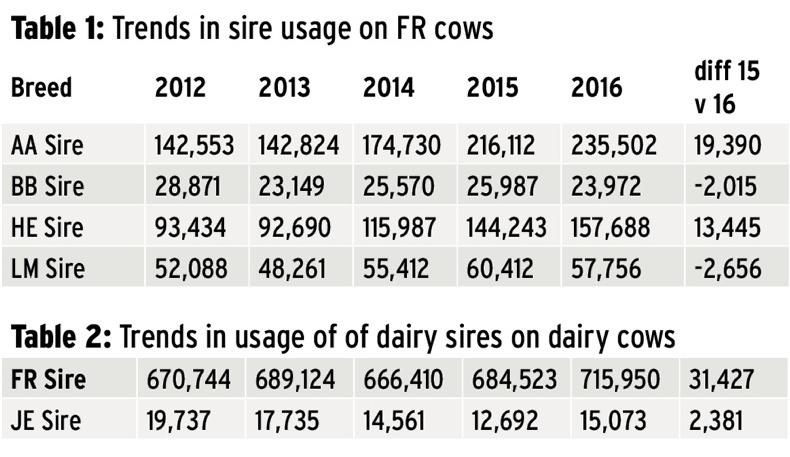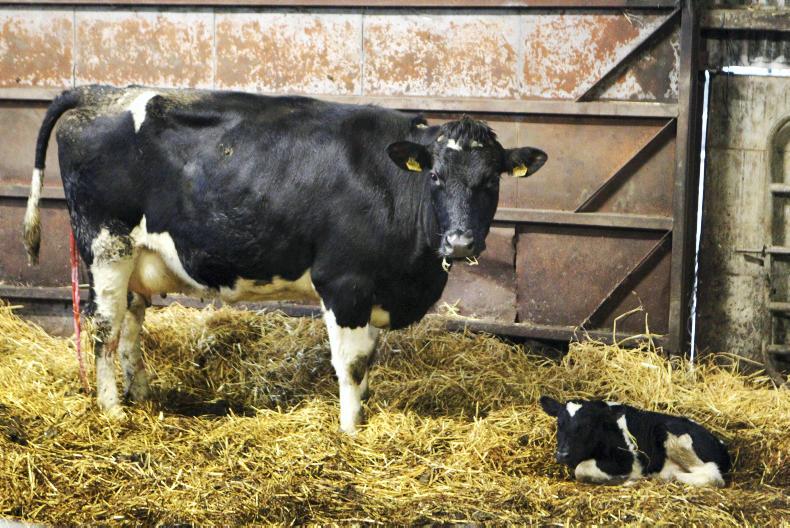New data shows that the EBI of genomically tested animals is over-estimated by up to €30 to €40. This data is emerging as the proofs on the first genomically tested bulls become more reliable as their progeny are tested.
There is also a plan to include younger bulls in the active bull list. Previously, bulls were included in the active bull list when their calving proof from the calving season 12 months previous was used. The proposal now is to include bulls on the list that have a calving proof from births in the calving season just prior to the breeding season.
The ICBF and industry representatives are meeting to discuss these issues. A number of other changes to the EBI was proposed at a meeting in January. One of the proposed changes is to the maintenance sub-index.
At the moment, the maintenance sub-index is calculated based on the cull cow carcase weight. Heavy carcase weights have a lower maintenance value, as it is presumed that heavier cows eat more than lighter cows so they are penalised in the maintenance sub-index. On the flip side, heavier cows are rewarded in the beef sub-index.
The maintenance sub-index currently rewards cows with €1.49 for every kilogramme of carcase weight below the base level, while the beef sub-index rewards cows with €0.15 for every kilogramme of carcase weight above the base. The maintenance sub-index is worth 7% of the EBI, while the beef sub-index is worth 9% of the EBI.
With more farmers now recording cow liveweights, the ICBF is in a position
to switch from using cull cow carcase weights to using actual liveweights to calculate the maintenance sub-index, with 440,000 records now available on 228,000 cows.
The advantages of moving to liveweight is that the data will be more accurate because there will be no difference in killout. The database will also be updated quicker, as currently it is not until the animal is slaughtered that the data is used.
Health
The health sub-index is currently worth 3% of the EBI. There are three health traits feeding into the database – lameness, SCC and mastitis incidence.
However, the amount of recording being done of these traits on farms is low.
The ICBF presented data showing that just 78 herds recorded lameness incidence in 2016, while just 376 herds recorded mastitis incidences.
Interestingly, lameness and mastitis recording peaked in Ireland in the early part of this decade. In 2012, there was 1,659 lameness incidences recorded and 1,633 mastitis incidences recorded. That was during the height of the Dairy Efficiency Programme (DEP) scheme.
Without accurate recording of these health issues on farms, the data will not be much use, so farmers must do more to record lameness and mastitis incidences. Data on SCC comes primarily through milk recording results.
The ICBF now has an opportunity to introduce other health traits into the EBI. Research carried out by Teagasc Moorepark shows that liver fluke is about 2% heritable and there are some bulls who have much higher incidences of it than others.
The same applies for TB, bacteria and other parasites. The ICBF plans to introduce fluke to the health sub-index shortly.
Milk recording
The ICBF is also proposing changes to the way milk recording information is fed into genetic correlations. At the moment, 305-day milk yield is used but the proposal is to follow other countries such as New Zealand, Holland and Canada among others and switch to a test-day model.
The advantages of this would be the better estimate of environmental effects such as the influence of particular days of recording. It would also lead to better modelling of individual cow lactation curves and their milk yield persistency through lactation.
This change was first proposed in 2013, but the ICBF ran into problems with using fat results as the correlation hasn’t been accurate enough. It is hoped that it will be in a position to roll the test-day model after the fat issue is resolved later in the year.

Read more
Special focus: spring AI 2017
New data shows that the EBI of genomically tested animals is over-estimated by up to €30 to €40. This data is emerging as the proofs on the first genomically tested bulls become more reliable as their progeny are tested.
There is also a plan to include younger bulls in the active bull list. Previously, bulls were included in the active bull list when their calving proof from the calving season 12 months previous was used. The proposal now is to include bulls on the list that have a calving proof from births in the calving season just prior to the breeding season.
The ICBF and industry representatives are meeting to discuss these issues. A number of other changes to the EBI was proposed at a meeting in January. One of the proposed changes is to the maintenance sub-index.
At the moment, the maintenance sub-index is calculated based on the cull cow carcase weight. Heavy carcase weights have a lower maintenance value, as it is presumed that heavier cows eat more than lighter cows so they are penalised in the maintenance sub-index. On the flip side, heavier cows are rewarded in the beef sub-index.
The maintenance sub-index currently rewards cows with €1.49 for every kilogramme of carcase weight below the base level, while the beef sub-index rewards cows with €0.15 for every kilogramme of carcase weight above the base. The maintenance sub-index is worth 7% of the EBI, while the beef sub-index is worth 9% of the EBI.
With more farmers now recording cow liveweights, the ICBF is in a position
to switch from using cull cow carcase weights to using actual liveweights to calculate the maintenance sub-index, with 440,000 records now available on 228,000 cows.
The advantages of moving to liveweight is that the data will be more accurate because there will be no difference in killout. The database will also be updated quicker, as currently it is not until the animal is slaughtered that the data is used.
Health
The health sub-index is currently worth 3% of the EBI. There are three health traits feeding into the database – lameness, SCC and mastitis incidence.
However, the amount of recording being done of these traits on farms is low.
The ICBF presented data showing that just 78 herds recorded lameness incidence in 2016, while just 376 herds recorded mastitis incidences.
Interestingly, lameness and mastitis recording peaked in Ireland in the early part of this decade. In 2012, there was 1,659 lameness incidences recorded and 1,633 mastitis incidences recorded. That was during the height of the Dairy Efficiency Programme (DEP) scheme.
Without accurate recording of these health issues on farms, the data will not be much use, so farmers must do more to record lameness and mastitis incidences. Data on SCC comes primarily through milk recording results.
The ICBF now has an opportunity to introduce other health traits into the EBI. Research carried out by Teagasc Moorepark shows that liver fluke is about 2% heritable and there are some bulls who have much higher incidences of it than others.
The same applies for TB, bacteria and other parasites. The ICBF plans to introduce fluke to the health sub-index shortly.
Milk recording
The ICBF is also proposing changes to the way milk recording information is fed into genetic correlations. At the moment, 305-day milk yield is used but the proposal is to follow other countries such as New Zealand, Holland and Canada among others and switch to a test-day model.
The advantages of this would be the better estimate of environmental effects such as the influence of particular days of recording. It would also lead to better modelling of individual cow lactation curves and their milk yield persistency through lactation.
This change was first proposed in 2013, but the ICBF ran into problems with using fat results as the correlation hasn’t been accurate enough. It is hoped that it will be in a position to roll the test-day model after the fat issue is resolved later in the year.

Read more
Special focus: spring AI 2017







 This is a subscriber-only article
This is a subscriber-only article











SHARING OPTIONS: